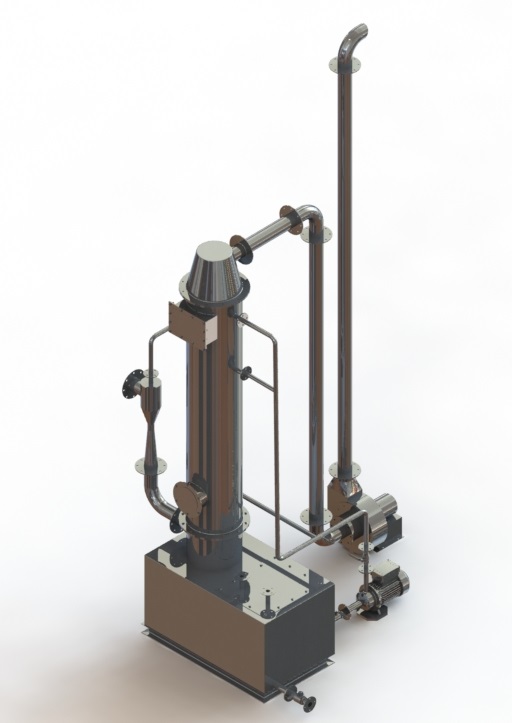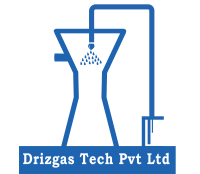Advantages
- Relatively low pressure drop – Pressure drop is the pressure difference that occurs as exhaust gas is pushed or pulled through the scrubber, disregarding the pressure that would be used for pumping or spraying the liquid into the scrubber.
- Fiberglass-reinforced plastic (FRP) construction permits operation in highly corrosive atmospheres
- Capable of achieving relatively high mass-transfer efficiencies
- The height and/or type of packing can be changed to improve mass transfer without purchasing new equipment
- Relatively low capital cost
- Relatively small space requirements
Applications
- Process vent emission
- Storage tank vent emission
- Emergency SO2 scrubbing
- Exhaust gas scrubbing
- Boiler exhaust gas scrubbing
- Flue gas scrubbing
- Flue gas desulfurization

Mechanism
SO2 scrubber
What is sulfur dioxide (SO2)?
- Sulfur dioxide is a colorless gas that can be released into the air through various manufacturing processes, particularly through the combustion of coal for power generation.
- SO2is also released to the air from natural sources, but on average, human activities are the predominant global source.
Exposure limit of SO2
OSHA PEL
- Permission exposure limit : 2 ppm (Time Weighted Limit)
- Short-Term Exposure Limit (STEL) : 5 ppm
Desulfurization
- A SO2scrubber system is the informal name for flue gas desulfurization (FGD) technology, which removes, or “scrubs,” SO2 emissions from the exhaust of coal-fired power plants. A scrubber works by spraying a wet slurry of limestone into a large chamber where the calcium in the limestone reacts with the SO2 in the flue gas.
- There are some variations in design of scrubbers. For example, some scrubbers may use other chemicals such as lime or magnesium oxide to react with the SO2in the flue gas.
Working principle
- Packed-bed scrubbers, also called wet scrubbers or absorbing towers, are pieces of equipment installed in power plants to remove SO2 gases from combustion fumes in order to meet emission standards.
- The key aspect of the process is the dissolution of the gas from the fumes into a liquid made of water with suitable additives. The outflowing liquid is collected, concentrated, and recycled. Ultimately, the stripped gas ends up as a solid residue.
- A scrubber is a vertical tank (tower) in which gas and liquid flow against each other: The liquid solution flows downward while the gas bubbles to the top, each moved under the action of gravity.
- To maximize contact between liquid and gas, the tower is also packed with a large number of small objects forcing the liquid to percolate slowly through tortuous paths and the gas to rise in small bubbles.
- As the liquid and gas compete for space, very intimate contact takes place between the two, and a very large contact area exists through which the transfer of chemical species can take place.
- The counter flow with vapor moving upward and liquid downward is very practical for two reasons: (1) It happens naturally by gravity as the liquid trickles down while the gas bubbles up through it, and (2) the fumes encounter increasingly less loaded liquid as they get progressively cleaner on their way upward
The chemistry of desulfurization
The liquid used to “wash” the flue gas is a water-based calcium solution.
Limestone (CaCO3) is cheap and creates an alkaline environment in water:
CaCO3 + H2O « Ca++ + HCO3 – + OH–
This OH– radicals bind with SO2 in solution to form a sulfur ion:
SO2 + OH – « HSO3 –
while water always dissociates a bit:
H2O « H+ + OH– and
while the bicarbonate HCO3 – ions bind with H+ to create H2CO3 (carbonic acid), which creates an equilibrium with water (H2O) and carbon dioxide (CO2):
HCO3 – + H+ « H2CO3 « H2O + CO2
The net result is the transformation of CaCO3 to calcium ions (Ca++), the release of carbon dioxide and production of HSO3 – :
CaCO3 + 2 SO2 + H2O « Ca++ + CO2 + 2 HSO3 –
The carbon dioxide bubbles up as a gas, while HSO3 – remains in the water solution.
Once collected at the bottom, the laden solution (a Calcium solution in the case of SO2) undergoes further reactions until a more valuable substance can be extracted, such as calcium sulfite (CaSO3) or calcium sulfate (CaSO4), which can be turned into plaster board.
Features
- Capacity from 20 to 100,000 CFM
- High-efficiency packing for removal of soluble/reactive gases and liquid droplets down to 7 microns Lower portion of shell serving as integral sump for recycle liquid
- Single spray nozzle liquid distributor for minimum fouling
